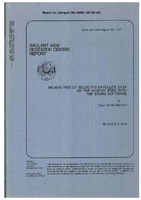| dc.contributor.author | Wannamaker, Brian | |
| dc.date.accessioned | 2018-10-11T14:06:37Z | |
| dc.date.available | 2018-10-11T14:06:37Z | |
| dc.date.issued | 1986/11 | |
| dc.identifier | 1883 | |
| dc.identifier.govdoc | SR-103 | |
| dc.identifier.uri | http://hdl.handle.net/20.500.12489/276 | |
| dc.description.abstract | Data from selected orbits of the NOAA-7 meteorological satellite are used for an exploratory analysis | |
| dc.description.abstract | of the surface variability in the area of the Aegean Sea using the STARS software system. The data | |
| dc.description.abstract | suggest that a patch of cooler water (<22 deg C in summer) in the north-west Aegean is due to mixing | |
| dc.description.abstract | in the Dardanelles. Another cool patch in the Gulf of Corinth may be due to wind-induced upwelling | |
| dc.description.abstract | and tidal-induced mixing. Excellent correlation is found between albedo (here a measure of surface | |
| dc.description.abstract | roughness) and surface temperature, with low albedo associated with high temperature; the relative | |
| dc.description.abstract | patterns are displaced spatially depending upon the topography of the adjacent shoreline | |
| dc.format | 25 p. : ill. ; 13 fig. | |
| dc.language | English | |
| dc.publisher | NATO. SACLANTCEN | |
| dc.relation.ispartofseries | ADA179047 | |
| dc.subject | Aegean Sea | |
| dc.subject | Remote sensing | |
| dc.title | An analysis of selected satellite data of the Aegean area with the STARS software | |
| dc.type | Scientific Report (SR) | |
